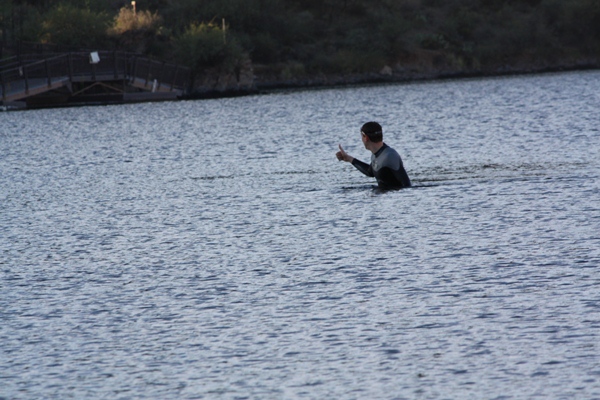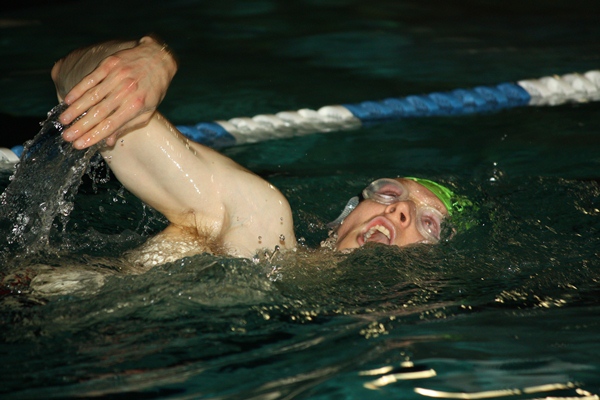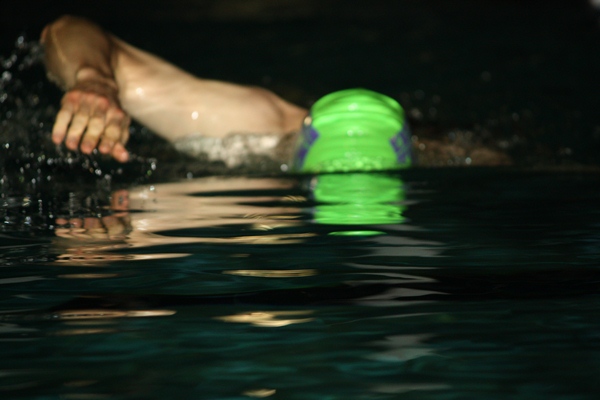Or: How I learned to stop fighting and trust the water, with Total Immersion

When I talk to non-triathlon folk about triathlon, the conversation usually goes something like this one, featuring my fictitious friend, Jessie.
Jessie: “Yo, what are the distances, again?”
Me: “For Ironman, its a 2.5-mile swim, 112-mile ride and a 26.2-mile run.”
Jessie: “For real? You’re crazy, man.”
Me: uncomfortable laughter
Jessie: “Yo, I could never do a triathlon.”
Me: “It’s not as bad as you think.”
Jessie: “Like, I guess I’d be ok on the bike and run, you know – but I wouldn’t be able to get through that swim, yo.”
Me: “Dude. That’s what everybody says. And that’s what I thought at first, too. But once you learn the right technique, the swim is the easiest part of the race.”
Jessie: “I don’t know – I just ain’t all that comfortable in the water. And yo – there’s nothing to hang on to out there in the open water. What if I panic or something?”
This gets me riled up because fearing the swim is such a common misconception – and one that I fell for too.
“But if you swim properly, you won’t get tired!” I retort, as Jessie rolls his eyes.
I go on to explain how when I went from fighting and hating the water with every flailing stroke, to swimming silently, efficiently and – most importantly – happily.
I brag about how it used to take me at least 18 strokes to get from one end of the 25-meter pool to the other, and now I swim laps consistently in 12 strokes or less, almost effortlessly.
“Total Immersion, bitch!” I shout, holding my hand up for a high five.
Unfortunately Jessie leaves me hangin’ – by that point in the conversation, he’s already made up his mind and has turned his attention toward his video games and pizza.
– End Scene –
Whether you’re afraid of the water like Jessie, a beginner triathlete struggling through swim practice, or a seasoned competitor looking for ways to shave minutes off your time, you need to understand that the swim can be the least taxing part of a triathlon.
It’s all a matter of strategy, body mechanics and practice.
Ready to see the light?

Total Immersion 101
If you’re anything like I was, you try to swim fast and lean on your fitness and strength to pass people and make it out of the water before the masses. And as much as you try, you still find yourself struggling, gasping for air and near the back of the pack.
The drive, dedication and fitness are all there, so what’s the problem?
It’s not working because all the effort is pointed in the wrong direction.
The Total Immersion strategy gets us back on track by setting some new goals for the triathlon swim: conserve energy, reduce drag, and exit the water fresh with a full tank for the bike and run ahead.
Instead of strengthening muscles to fight harder in the water, we’re going to instead focus on positioning the vessel.
In a nutshell, you need to learn how to reduce drag, effortlessly glide through the water (instead of kicking, splashing and crawling across it).
And it’s obviously not as easy as it sounds. Yes, just showing up to the pool is a big part of the battle, but you’re not going to get better by following Dottie’s advice to “Just keep swimming.”
Say goodbye to mindless swim workouts. The counter-intuitive Total Immersion techniques need to be studied, practiced and repeated.
After all, we’re land mammals and the laws of physics work against us in the water. We need to fight back like a really smart fish.
Here’s how.
Dip your toes in the water
For starters, watch this five-minute segment in Tim Ferriss’s Ted Talk: How to feel like the Incredible Hulk. He explains three Total Immersion concepts that helped him conquer his lifelong fear of the water. It’s a nice quick breakdown.
Check out this Total Immersion presentation by Terry Laughlin on YouTube. He goes into details and gives you an idea of what to expect.
Buy the book, Triathlon swimming made easy by Terry Laughlin. It’s an easy read and essential for any triathlete’s library. I learned all of the tips, drills and concepts in this article either directly or indirectly from reading the book.
I also recommend the Total Immersion DVD Perpetual Motion Freestyle in 10 Lessons for simple visual guides and examples of the technique.

Jump in
Read the book cover to cover, watch the DVD, take notes and practice the Total Immersion preachings.
Pick out the lessons and drills that really resonate and work for you, and keep them in mind every time you get in the water.
Here are some tips and drills that worked for me:
- Count your strokes. Try to get from one end of the pool to the other in the least number of strokes. Stay consistent.
- Swim silently. Slice your hand in the water, next to your head. Reach through the water (not over) with a weightless arm forward. Try to make no splash and no bubbles.
- Learn how to balance with your core (not your arms) horizontally, and convince yourself the water is a friend and can be trusted to support you. Practice the sweet spot drill. When swimming, hide your head under the water and look straight down at the bottom of the pool. Practice side-lying balance with the fish drill – basically balancing, rotating, breathing and swimming without using your arms. Do fish need arms to swim? Nope. And neither do you!
- Generate power by rolling your body from side to side with each stroke. This is tough to master. Practice the skate and skate-switch drills to train your core to perform the whole-body movement and carry momentum forward with each roll. Roll your body to where the air is – like you’re breathing out of your belly button.
- There’s a lot to remember and practice, but don’t try to improve everything at once. Instead, swim slowly and focus on one component at a time. Every lap should have a key purpose (find your one thing!). For example, one lap concentrate on dropping your head, next lap keeping your hips up and weightless, next silent strokes, and so on.
Total Immersion requires more discipline than just jumping in the water and swimming mindlessly for an hour.
If you put in the time to set the right foundation and get through these growing pains, swimming will be the easiest part of the triathlon and you’ll have the rest of your life to keep improving your technique and enjoying the water.
– Live every day –
Name one part of your swim that you’re going to focus on improving.
What drill or tip has helped you the most to swim like a fish?